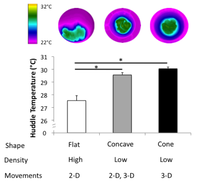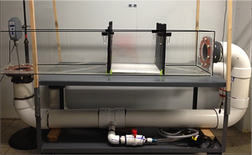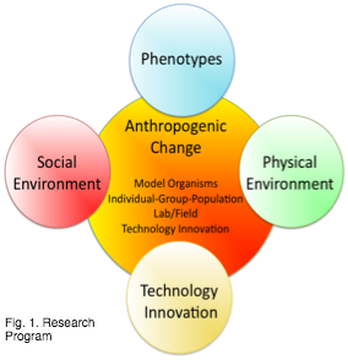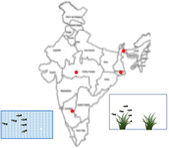|
News
03/14/2024 ACCEPTED "Plants buffer some of the effects of a pair of cadmium-exposed zebrafish on the un-exposed majority" Environmental Toxicology and Pharmacology 01/12/2024 CONGRATULATIONS MD Imran Noor for winning 1st place and Jessica Okutsu for 3rd place posters at the BioGrad symposium 12/15/2023 TOP CITED paper in Zebrafish Shelton et al., 2020. |
EPIC Work. |
Overview
To protect ecosystems and human health we must understand how the physical and social environments interact to produce phenotypes. Environments are expected to change at alarming rates. Thus, there is a need to understand how environmental features impact multi-level organizations (e.g., individuals-groups-populations) to predict consequences and mitigate risk. We am interested in identifying the environmental mechanisms that influence behavior-physiology-genes, and their long-term consequences using model systems (Shelton & Martins, 2017). Given the addition of multi-level behavioral and physiological phenotyping, novel tools are needed to assess environmentally-determined phenotypes; therefore, my research program is also dedicated to the development and commercialization of new technologies. Research focused on environmentally-induced phenotypes in groups can help provide solutions for grand challenges including conservation efforts tasked with managing at risk groups, assessing the impact of contamination events, enhancing the resilience of groups to effects of climate change, and increasing group productivity.
1) Which environmental mechanisms shape social behavior in the lab and field?
 Fig 2. Huddle temperature is more influenced by density than the shape of the nest.
Fig 2. Huddle temperature is more influenced by density than the shape of the nest.
While traditional empirical and epidemiological approaches have advanced our understanding of the impact of environmental features on individual behavior and disease (e.g., water flow, elevated temperatures, vegetation, contaminants); surprisingly, little is known about the impact of these environmental features on multi-level organizations and their behavior-brain-gene mechanisms. As a response, my research program is centered on identifying the environmental and physiological mechanisms of the development and evolution of collective behavior in the lab and field.
We identified simple environmental features that shape collective behavior in small animal groups, mouse huddles (Mus musculus) and zebrafish shoals (Danio rerio). In mice, we studied how environmental structure (e.g., ambient temperatures, nest configuration) influenced the expression of group behavioral regulation, social structure, and thermal physiology across development. With the help of an NSF REU student, Karen Ocasio, we found that nest structure can lead to contrasting developmental trajectories (Shelton & Alberts, 2018) and have energetic consequences (Fig 2; Shelton et al., 2017).
We identified simple environmental features that shape collective behavior in small animal groups, mouse huddles (Mus musculus) and zebrafish shoals (Danio rerio). In mice, we studied how environmental structure (e.g., ambient temperatures, nest configuration) influenced the expression of group behavioral regulation, social structure, and thermal physiology across development. With the help of an NSF REU student, Karen Ocasio, we found that nest structure can lead to contrasting developmental trajectories (Shelton & Alberts, 2018) and have energetic consequences (Fig 2; Shelton et al., 2017).
|
In zebrafish, we examined how the physical environment influences shoal cohesion and group responses. In collaboration with two NSF REU interns, Brittany Price and Karen Ocasio, we found that density was important in shaping shoal cohesion, but not coordination (Shelton et al., 2015). We integrated laboratory and field experiments to identify the influence of water flow and vegetation on social behavior in zebrafish (Fig. 3; Suriyampola, Shelton et al., 2015; Suriyampola et al., 2016; Kelly et al., 2021). We found that water flow, but not vegetation was a salient factor influencing aggression, cohesion and alignment (or polarity) in wild and hatchery-reared strains of zebrafish (Suriyampola et al., 2021). We also documented the largest group sizes of zebrafish in the literature (Shelton et al., 2020).
|
2) How do environmental contaminants induce behavioral and sensory disorders?
Pollution is one of the greatest challenges to the Anthropocene Epoch, threatening the stability of ecosystems and human societies (Landrigan et al., 2017). To protect ecosystem and human health, we must identify the direct and indirect effects of pollution. Recent studies implicate sublethal effects in behavioral deficits, antisocial behavior, sensory impairments, cancer, learning disabilities, and achievement gaps, which are adverse effects associated with cadmium. Toxicology testing has traditionally focused on individual lethal effects, missing the sublethal and social impacts. Dr. Shelton's research program examines the direct and indirect effects of contaminants on social behavior, brain, physiology, and genes across generations, thereby providing a more holistic examination of inter- and trans-generational pollutant effects in social groups. This work is funded by 2020-2025 NIH NIEHS K99/R00 Pathways to Independence Award.
We found that cadmium had direct effects on vision and aggression, and indirect effects on boldness, social behavior, and landmark use of un-exposed groups containing a few cadmium-exposed fish (Shelton et al., submitted). I hypothesized that the indirect group effects were mediated through direct effects on the visual system. My lab continues to understand sensory mechanisms that influence this indirect effect by employing toxicological methods, pharmacological techniques, and high-throughput screening.
We found that cadmium had direct effects on vision and aggression, and indirect effects on boldness, social behavior, and landmark use of un-exposed groups containing a few cadmium-exposed fish (Shelton et al., submitted). I hypothesized that the indirect group effects were mediated through direct effects on the visual system. My lab continues to understand sensory mechanisms that influence this indirect effect by employing toxicological methods, pharmacological techniques, and high-throughput screening.
3) Discovery to Market: developing behavioral and physiological screens to meet consumer needs

Research and Development (R&D) in toxicology, pharmacology, and basic research is hinged on animal models to quickly, accurately, and cheaply assess the efficacy and adverse effects of compounds and products. To meet these growing needs zebrafish have assailed as the model of choice due to their small size, high reproductive output, quick generation time, and genetic tractability. Zebrafish are estimated to be in >3250 institutions across 100 countries (Lawrence, 2016). Their use is expected to increase with the advent of rapid clustered regularly interspaced short palindromic repeats (CRISPR)–cas9 gene editing that will affect many D. rerio models and increase overall research intensity. The progress of academic and industry research is also dependent on tools to quickly identify the direct and indirect effects of their compounds and products of human and ecosystem health.
To meet these needs, we have developed a flow tank (Shelton et al., 2015), that we significantly improved by incorporating a multisensory component (Suriyampola et al., 2021). The flow tank is a multi-chamber device that can assess lateral line, vision, and olfactory responses.
Vision is an important sensory modality in most vertebrates and many invertebrates. We developed an assay to assess optomotor responses in zebrafish (Videos 1 &3) and salmon (Videos 2 & 4). We have since improved the technology. We worked with engineers to develop Visioglow, a platform technology that assesses multiple aspects of vision in 20s in multiple species. Visioglow warranted an institutional disclosure through Oregon State Universities Office of Commercialization and Commercial Development. In support of a commercialization plan, Dr. Delia Shelton was awarded an NSF Innovation-Corps with Molly Arnold and an industry mentor, and advisor Karl Mundorff. Discovery-invention-market is a research pathway that is central in my research program. I will continue to develop tools to answer next generation questions.
To meet these needs, we have developed a flow tank (Shelton et al., 2015), that we significantly improved by incorporating a multisensory component (Suriyampola et al., 2021). The flow tank is a multi-chamber device that can assess lateral line, vision, and olfactory responses.
Vision is an important sensory modality in most vertebrates and many invertebrates. We developed an assay to assess optomotor responses in zebrafish (Videos 1 &3) and salmon (Videos 2 & 4). We have since improved the technology. We worked with engineers to develop Visioglow, a platform technology that assesses multiple aspects of vision in 20s in multiple species. Visioglow warranted an institutional disclosure through Oregon State Universities Office of Commercialization and Commercial Development. In support of a commercialization plan, Dr. Delia Shelton was awarded an NSF Innovation-Corps with Molly Arnold and an industry mentor, and advisor Karl Mundorff. Discovery-invention-market is a research pathway that is central in my research program. I will continue to develop tools to answer next generation questions.
|
|
|
|
Video 1. Adult zebrafish (Danio rerio) showing a positive optomotor response.
|
Video 2. Juvenile Chinook salmon (Oncorhynchus tshawytscha) showing a positive optomotor response.
|
|
|
|
|
Video 3: Adult zebrafish showing no optomotor response.
|
Video 4: Juvenile Chinook salmon showing no optomotor response.
|

